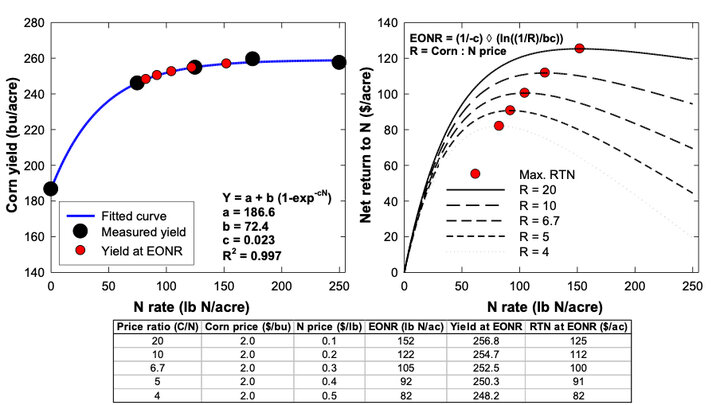This article is the third in a six-part companion series to the Nebraska Extension NebGuide G2365, “In-Season Nitrogen Management for Irrigated Corn.” Each article will explore critical concepts from the guide that growers have expressed a need for greater guidance on, offering additional insights and practical recommendations to help optimize nitrogen use and profitability.
The economic optimum nitrogen fertilizer rate (EONR) is a standard benchmark for fertilizer nitrogen (N) recommendations in corn. University of Nebraska-Lincoln (UNL) fertilizer N recommendations have long been based on this principle: growers should apply N fertilizer at the rate that maximizes profit. Research has also shown that when fertilizer N is applied at this rate, environmental impacts are minimized — N loss increases significantly if fertilizer is applied at higher rates to maximize yield instead of profit.
But how is EONR determined? It begins with knowing the price of fertilizer and the value of the crop produced. In practice, though, it can only be determined after the growing season by comparing treatments with differing N rates to identify where profit was maximized for that field in that year. Importantly, EONR represents only the specific area of the field where treatments were located, since soil and weather conditions will vary — sometimes slightly, sometimes significantly — across a field.

Figure 1 illustrates how EONR is determined, using a research study at the South Central Ag Lab in 2002. The left graph shows corn yield response to fertilizer N rate plots in the field —a very typical response curve where yield increases more slowly for each additional pound of N, until a maximum yield level is reached. The right graph demonstrates how EONR shifts with different corn-to-fertilizer N price ratios.
Depending on the corn-to-fertilizer price ratio, yield at EONR ranged from 248 to 256 bu/acre, while EONR ranged from 82 to 152 lb fertilizer N/acre.
However, EONR for this field was determined under specific conditions: Crete silt loam soil, ammonium nitrate fertilizer, split-applied (broadcast at-planting and banded at sidedress), with soybean as the previous crop, minimal N in irrigation water, no cover crop use, and low soil residual nitrate. Any change in these parameters — especially N fertilizer source, application timing or weather — would result in a different EONR.
So where does the EONR in UNL recommendations come from? It is derived from many site-years of research on crop response to N rate, from which an average EONR for each set of conditions: soil type, previous crop, application method and other N credits.
The interactions of N fertilizer source, N application timing, placement and weather quickly become too complex to capture in field studies. It is possible to include two or three sources, timings or placements in field research, but testing every possible combination — while also accounting for soils and weather influences — is impossible. Instead, models are increasingly used to provide estimates of EONR by integrating interactions among these variables.
In reality, it is impossible to know the exact EONR for a field ahead of the growing season, because actual weather for the field is unknown. While we can forecast weather regionally for the growing season, we cannot predict daily rainfall and temperature at the field level.
As a result, the predicted EONR for a field in a given growing season will always have a margin of error due to uncertainties in all the influencing factors.
Consequently, we have found that sensor-informed, in-season N management — which responds to crop N demand in real time based on growing season weather conditions — generally produces more accurate fertilizer N recommendations than N rate prediction equations that aim to predict EONR in advance. Research findings published annually through the Nebraska On-Farm Research Network provide excellent examples of how EONR can vary widely across fields and years.

